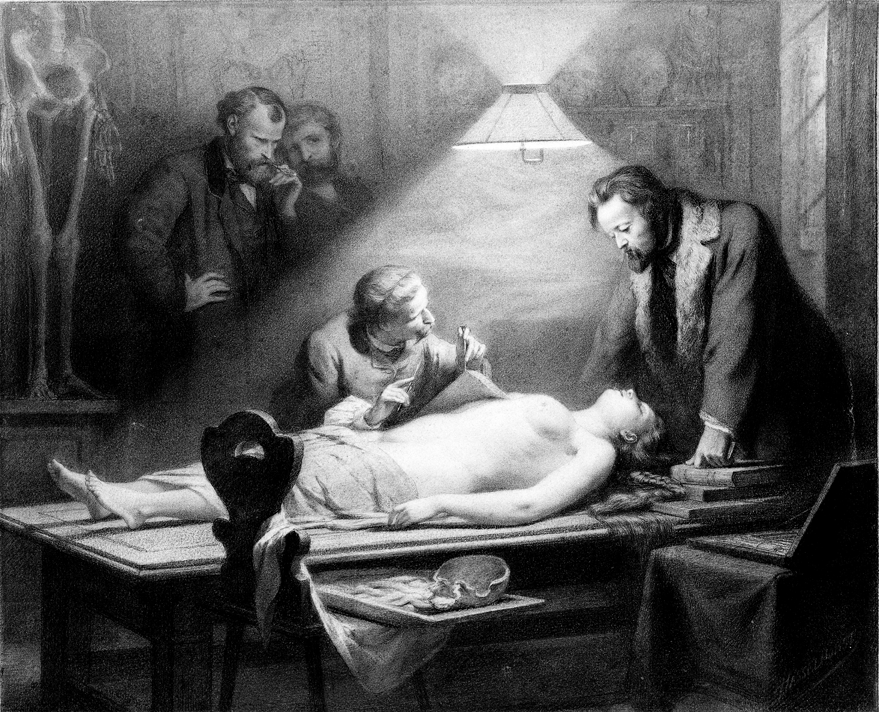Knowledge
After a chalk drawing by
J.H. Hasselhorst, 1864
Whoever she was, she comes to us like this:
lips parted, long hair spilling from the table
like water from a pitcher, nipples drawn out
for inspection. Perhaps to foreshadow
the object she’ll become: a skeleton on a pedestal,
a row of skulls on a shelf. To make a study
 of the ideal female body, four men gather around her.
She is young and beautiful and drowned—
a Venus de' Medici, risen from the sea, sleeping.
As if we could mistake this work for sacrilege,
the artist entombs her body in a pyramid
of light, a temple of science over which
the anatomist presides. In the service of beauty—
to know it—he lifts a flap of skin
beneath her breast as one might draw back a sheet.
We will not see his step-by-step parsing,
a translation: Mary or Katherine or Elizabeth
to corpus, areola, vulva. In his hands
instruments of the empirical—scalpel, pincers—
cold as the room must be cold: all the men
in coats, trimmed in velvet or fur—soft as the down
of her pubis. Now one man is smoking, another
tilts his head to get a better look. Yet another,
at the head of the table, peers down as if
enthralled, his fist on a stack of books.
In the drawing this is only the first cut,
a delicate wounding and yet how easily
the anatomist’s blade opens a place in me,
like a curtain drawn upon a room in which
each learned man is my father
and I hear, again, his words—I study
my crossbreed child—misnomer
and taxonomy, the language of zoology. Here,
he is all of them: the preoccupied man—
an artist, collector of experience, the skeptic angling
his head, his thoughts tilting toward
what I cannot know; the marshaller of knowledge,
knuckling down a stack of books; even
the dissector—his scalpel in hand like a pen
poised above me, aimed straight for my heart.
of the ideal female body, four men gather around her.
She is young and beautiful and drowned—
a Venus de' Medici, risen from the sea, sleeping.
As if we could mistake this work for sacrilege,
the artist entombs her body in a pyramid
of light, a temple of science over which
the anatomist presides. In the service of beauty—
to know it—he lifts a flap of skin
beneath her breast as one might draw back a sheet.
We will not see his step-by-step parsing,
a translation: Mary or Katherine or Elizabeth
to corpus, areola, vulva. In his hands
instruments of the empirical—scalpel, pincers—
cold as the room must be cold: all the men
in coats, trimmed in velvet or fur—soft as the down
of her pubis. Now one man is smoking, another
tilts his head to get a better look. Yet another,
at the head of the table, peers down as if
enthralled, his fist on a stack of books.
In the drawing this is only the first cut,
a delicate wounding and yet how easily
the anatomist’s blade opens a place in me,
like a curtain drawn upon a room in which
each learned man is my father
and I hear, again, his words—I study
my crossbreed child—misnomer
and taxonomy, the language of zoology. Here,
he is all of them: the preoccupied man—
an artist, collector of experience, the skeptic angling
his head, his thoughts tilting toward
what I cannot know; the marshaller of knowledge,
knuckling down a stack of books; even
the dissector—his scalpel in hand like a pen
poised above me, aimed straight for my heart.